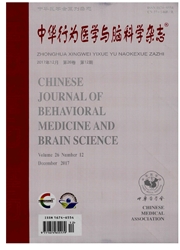

 中文摘要:
中文摘要:
目的观察喹硫平(quetiapine,QUE)对慢性不可预见应激(chronic unpredictable stress,CUS)模型大鼠行为学的改善作用及对海马磷酸化细胞外信号调节激酶(phosphorylated extracellular signal.regula—ted protein kinase,pERKl/2)表达的影响。方法32只sD大鼠按随机数字表法分为对照组(Contr01)、模型组(cus)、CUS+QUE(5mg/kg,L)组及CUS+QUE(10rag/kg,M)组,每组8只。除Control组外,余各组大鼠均接受CUS造模28d,随后Control组和CUS组大鼠连续7d接受含1%二甲基亚砜的生理盐水(5ml/kg体质量)腹腔注射,CUS+QUE(L)组和CUS+QUE(M)组大鼠腹腔注射QUE(分别为5me,/kg和10mg/kg体质量),连续7d。实验期间观察大鼠体质量的变化并在给药结束后采用旷场实验和强迫游泳实验评估大鼠抑郁样行为,用蛋白质印迹法(Westernblot)检测大鼠海马pERKl/2的表达水平。结果(1)体质量测试:持续28d的慢性不可预见应激抑制了动物体质量的增长(F=7.969,P〈0.05),而给予10mg/kg的喹硫平可以改善这种现象(与CUS组比较,P〈0.05),给予5mg/kg的喹硫平差异无统计学意义(P〉0.05)。(2)旷场和强迫游泳实验:各处理组大鼠在水平活动距离(F=17.846),进入中央区的总次数(F=4.720)以及强迫游泳静止时间(F=26.090),均差异有统计学意义(均P〈0.05)。与CUS组大鼠比较,Control组和CUS+QUE(M)组大鼠水平活动距离和进人中央区的总次数均显著增加,静止时问明显减少[分别为:CUS组:(6696.30±1061.19)nil3,(19.63±9.15)次,(110.73±15.98)s;Control组:(10824.61±1399.37)mm,(37.75±13.02)次,(66.13±5.18)s;CUS+QUE(M)组:9637.51±1630.16)mm,(32.38±6.23)次,(73.40±11.99)s;均P〈0.05]。而CUS+QUE(L)组与CUS组相比上述指标差异无统
 英文摘要:
英文摘要:
Objective To investigate the effect of quetiapine on the behavior and expression of pERK1/2 in chronic unpredictable stress(CUS) model rats. Methods 32 adult male Sprague Dawley rats were randomly divided into four groups ( n = 8 for each group ) : control group, CUS group, CUS + QUE (5 mg/kg, L)group and CUS + QUE( 10 mg/kg,M) group. The rats in control group were left undisturbed in their home cage for 28 days and the other groups were exposed to 28 consecutive days of CUS, then the rats in control group and CUS group were treated with 1% DMSO in saline ( 5 ml/kg, intraperitoneal injection), the rats in CUS + QUE (L) group and CUS + QUE(M) group respectively treated with quetiapine (5 mg/kg)or quetiapine (10 mg/kg) for consecutive 7 days. The weight data of each group were recorded, and the behavioral changes in these rats were analyzed by open field test and forced swimming test ; and the expression of pERK1/2 was measured by Western blot. Results ( 1 ) Compared with control group, quetiapine (10 mg/kg) ameliorated the inhibition of body weight gain that induced by chronic unpredictable stress (P〈0.05) ,but quetiapine (5 mg/kg) did not have this effect. (2)Open field and Forced swimming test showed significant difference (P 〈 0.05 ) of horizontal motion distance ( F = 17. 846 ), the number of central region entering( F= 4. 720) and the immobility time ( F = 26. 090) in each group. And these tests showed that horizontal motion distance and the number of central region entering in CUS group ( (6696.30 + 1061.19) ram, (19.63 + 9.15 )times) were significantly lower than that of control group ( (10824.61 ± 1399.37 )mm,(37.75±13.02)times) andCUS+QUE(M) group ( ( 9637. 51±1630.16 ) mm, ( 32. 38±6.23) ),while the immobility time ( 110.73 ± 15.98 ) s were significantly higher than that of control group ( (66.13 ± 5.18 ) s ) and CUS + QUE ( M ) group ( ( 73.40±
 同期刊论文项目
同期刊论文项目
 同项目期刊论文
同项目期刊论文
 Quetiapine andrepetitive transcranial magnetic stimulation ameliorate depression-likebehaviors and u
Quetiapine andrepetitive transcranial magnetic stimulation ameliorate depression-likebehaviors and u Gastrodin amelioratesanxiety-like behaviors and inhibits IL-1beta level and p38 MAPK phosphorylation
Gastrodin amelioratesanxiety-like behaviors and inhibits IL-1beta level and p38 MAPK phosphorylation Quetiapine AmelioratesSchizophrenia-Like Behaviors and Protects Myelin Integrity in CuprizoneIntoxic
Quetiapine AmelioratesSchizophrenia-Like Behaviors and Protects Myelin Integrity in CuprizoneIntoxic 期刊信息
期刊信息
